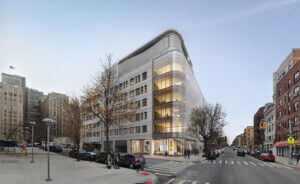The David & Helen Gurley Brown Institute for Media Innovation is a busy hub of technology housed within a building from McKim, Mead & White’s late 19th-century campus plan for Columbia University. In subsequent years, the space, which occupies part of the eastern wing of the Pulitzer Building, was broken up into small offices.
Marc Tsurumaki and his team at LTL Architects were hired to revamp the space for the Columbia branch of the institute, which is a collaboration between Columbia and Stanford Universities. Despite all of its high-tech screens, the institute’s facility really respects its history. Eleven double-height windows that had been partially blocked now bathe the room in natural light, although a scrim that covers the walls also serves as a shade to deflect daylight and prevent glare, a necessary consideration in a room that is always filled with people tapping away on laptops.
Given the collaborative nature of the institute, the primary space was designed with flexibility in mind. It can host concerts, performances, workshops, seminars, and symposia, in addition to the more typical set-up that we saw today. Large walnut-topped tables are moveable but not easily moved – the architects allowed for flexibility, but only with intention. Although acoustical fabrics are used throughout (including hidden behind the scrim), additional nooks were carved out for greater intimacy. Small rooms dubbed “the garage” are nestled under the mezzanine level, which was located above the entrance to the institute to create an extended threshold opening up into the larger space.
Niches along the northern wall of the room take advantage of its thick masonry construction. Waist-height walnut wainscoting gives the room a more human scale and links the niches to the larger space. The thick end-grain recycled walnut floor connects visually to the tables and wainscoting, and provides durability in an active setting.
The scrim, which is suspended on a steel armature and hides HVAC and electrical systems, announces the institute’s purpose. Mark Hansen, director of Columbia’s branch of the institute told us that Mark Wigley, former dean of Columbia’s Graduate School of Architecture, Planning and Preservation, and currently a GSAPP professor, talks about the space as both a laboratory that facilitates the cross-pollination of ideas among fellows, as well as a physical center that refers to and reflects the institute’s mission.
This agenda is reinforced at the entrance to the institute, where a solid plate aluminum installation incorporates mirrored glass to reflect the surroundings back into the display. This subtle mirroring plays with the relationship of new media to the historic building.
Join us tomorrow for a tour of another historic building: the Cooper Hewitt, Smithsonian Design Museum.










